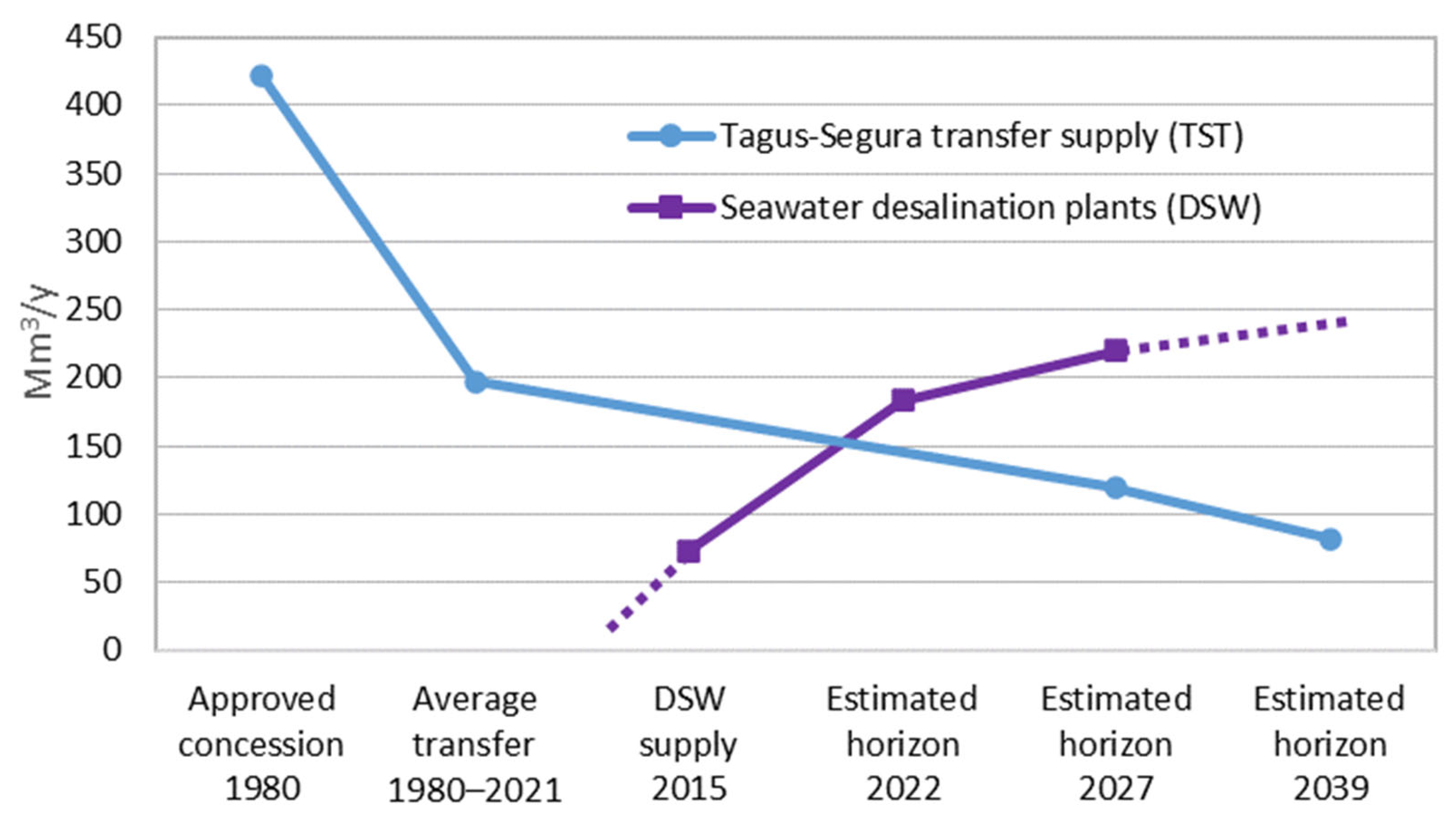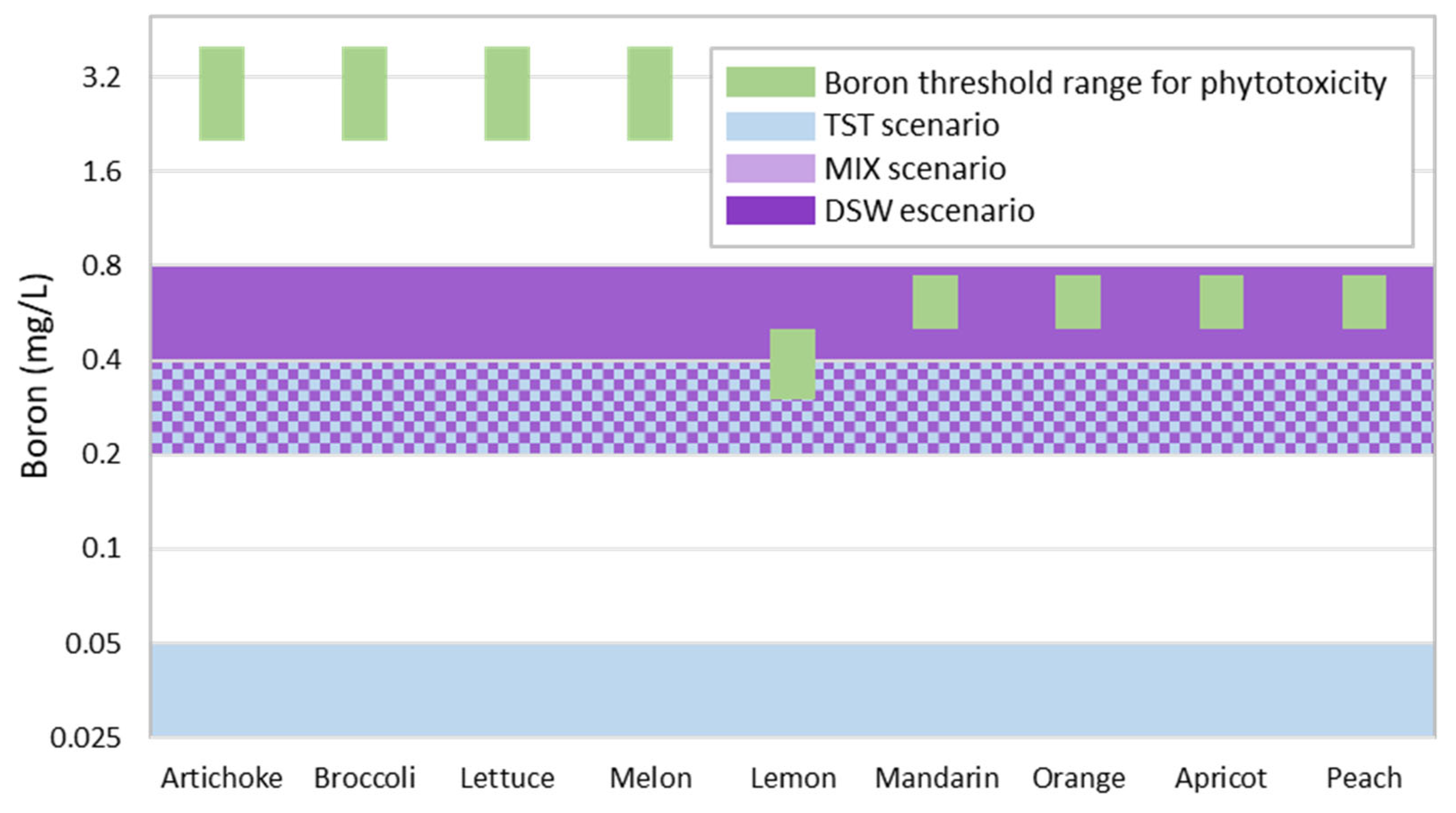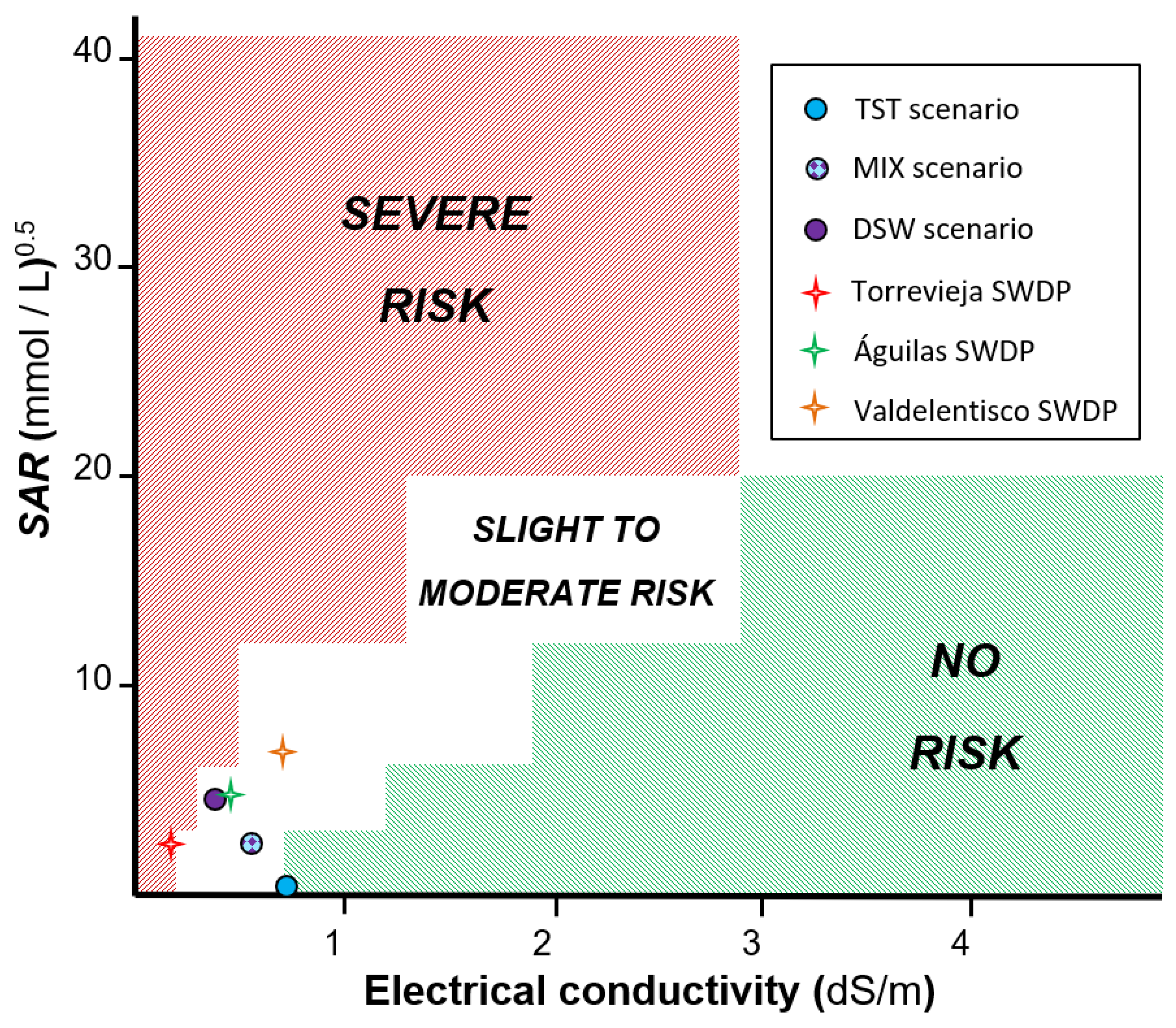Agronomic Analysis of the Replacement of Conventional Agricultural Water Supply by Desalinated Seawater as an Adaptive Strategy to Water Scarcity in South-Eastern Spain
Abstract
:1. Introduction
2. Materials and Methods
2.1. Evolution and Foreseeable Trend of TST and DSW Supplies in the Study Area
2.2. Water Sources and Supply Scenarios
- TST scenario. This was the situation prior to the implementation of seawater desalination for crop irrigation in the study area and corresponds to a 100% supply from the TST.
- MIX scenario. This represents the partial replacement (50%) of the TST supply by DSW and corresponds to a situation very similar to the current one in the study area.
- DSW scenario. This represents the total replacement of the TST supply by DSW and corresponds to a hypothetical future situation without the TST.
2.3. Crop Selection
2.4. Agronomic Impacts
2.4.1. Effect of Water Salinity on Crop Yield
2.4.2. Effect of Water Salinity on Total Irrigation Requirements
2.4.3. Effect of the Low Concentration of Essential Nutrients on the Cost of Fertilizers
2.4.4. Effect on Boron Phytotoxicity Risk
2.4.5. Effect on Soil Alkalinization Risk
3. Results and Discussion
3.1. Effect of Water Salinity on Crop Yield
3.2. Effect of Water Salinity on Total Irrigation Requirements
3.3. Effect of the Low Concentration of Essential Nutrients on the Cost of Fertilizers
3.4. Effect on Boron Phytotoxicity Risk
3.5. Effect on Soil Alkalinization Risk
4. Conclusions
Author Contributions
Funding
Data Availability Statement
Acknowledgments
Conflicts of Interest
References
- FAO. Water for Sustainable Food and Agriculture: A Report Produced for the G20 Presidency of Germany; Food and Agriculture Organization of the United Nations (FAO): Rome, Italy, 2017. [Google Scholar]
- Ahmed, M.; Asim, M.; Ahmad, S.; Aslam, M. Climate Change, Agricultural Productivity, and Food Security. In Global Agricultural Production: Resilience to Climate Change; Ahmed, M., Ed.; Springer: Cham, Switzerland, 2022. [Google Scholar]
- IPCC. Climate Change 2022: Impacts, Adaptation and Vulnerability; Intergovernmental Panel on Climate Change (IPCC); Cambridge University Press: Cambridge, UK; New York, NY, USA, 2022. [Google Scholar]
- Ward, F.A. Enhancing climate resilience of irrigated agriculture: A review. J. Environ. Manag. 2022, 302, 114032. [Google Scholar] [CrossRef] [PubMed]
- Qadir, M.; Sharma, B.R.; Bruggeman, A.; Choukr-Allah, R.; Karajeh, F. Nonconventional water resources and opportunities for water augmentation to achieve food security in water scarce countries. Agric. Water Manag. 2007, 87, 2–22. [Google Scholar] [CrossRef]
- Martínez-Alvarez, V.; Bar-Tal, A.; Diaz, F.J.; Maestre-Valero, J.F. Desalination of seawater for agricultural irrigation. Water 2020, 12, 1712. [Google Scholar] [CrossRef]
- Russo, D.; Kurtzman, D. Using desalinated water for irrigation: Its effect on field scale water flow and contaminant transport under cropped conditions. Water 2019, 11, 687. [Google Scholar] [CrossRef]
- Martínez-Alvarez, V.; González-Ortega, M.J.; Martin-Gorriz, B.; Soto-García, M.; Maestre-Valero, J.F. The use of desalinated seawater for crop irrigation in the Segura River basin (South-eastern Spain). Desalination 2017, 422, 153–164. [Google Scholar] [CrossRef]
- Daghari, I.; El Zarroug, M.R.; Muanda, C.; Kompany, J.R.; Kanzari, S.; Mimoun, A.B. Feasibility of water desalination for irrigation: The case of the coastal irrigated area of dyiar-Al-hujjej, Tunisia. Water Supply 2021, 21, 24–45. [Google Scholar] [CrossRef]
- Multsch, S.; Grabowski, D.; Lüdering, J.; Alquwaizany, A.S.; Lehnert, K.; Frede, H.-G.; Winker, P.; Breuer, L. A practical planning software program for desalination in agriculture—SPARE: WATERopt. Desalination 2017, 404, 121–131. [Google Scholar] [CrossRef]
- Hipólito-Valencia, B.J.; Mosqueda-Jiménez, F.W.; Barajas-Fernández, J.; Ponce-Ortega, J.M. Incorporating a seawater desalination scheme in the optimal water use in agricultural activities. Agric. Water Manag. 2021, 244, 106552. [Google Scholar] [CrossRef]
- Kim, H.; Kim, S.; Jeon, J.; Jeong, H. Effects of irrigation with desalinated water on lettuce grown under greenhouse in South Korea. Appl. Sci. 2020, 10, 2207. [Google Scholar] [CrossRef]
- Herrera-León, S.; Cruz, C.; Kraslawski, A.; Cisternas, L.A. Current situation and major challenges of desalination in Chile. Desalin. Water Treat. 2019, 171, 93–104. [Google Scholar] [CrossRef]
- Qin, Y.; Horvath, A. Use of alternative water sources in irrigation: Potential scales, costs, and environmental impacts in California. Environ. Res. Commun. 2020, 2, 055003. [Google Scholar] [CrossRef]
- Khondoker, M.; Mandal, S.; Gurav, R.; Hwang, S. Freshwater Shortage, Salinity Increase, and Global Food Production: A Need for Sustainable Irrigation Water Desalination—A Scoping Review. Earth 2023, 4, 223–240. [Google Scholar] [CrossRef]
- Yermiyahu, U.; Tal, A.; Ben-Gal, A.; Bar-Tal, A.; Tarchitzky, J.; Lahav, O. Rethinking desalinated water quality and agriculture. Science 2007, 318, 920–921. [Google Scholar] [CrossRef] [PubMed]
- Ben-Gal, A.; Yermiyahu, U.; Cohen, S. Fertilization and blending alternatives for irrigation with desalinated water. J. Environ. Qual. 2009, 38, 529–536. [Google Scholar] [CrossRef] [PubMed]
- Silber, A.; Israeli, Y.; Elingolds, I.; Levi, M.; Levkovitch, I.; Russo, D.; Assouline, S. Irrigation with desalinated water: A step toward increasing water saving and crop yields. Water Resour. Res. 2015, 51, 450–464. [Google Scholar] [CrossRef]
- Suwaileh, W.; Johnson, D.; Hilal, N. Membrane desalination and water re-use for agriculture: State of the art and future outlook. Desalination 2020, 491, 114559. [Google Scholar] [CrossRef]
- Martínez-Alvarez, V.; Imbernón-Mulero, A.; Gallego-Elvira, B.; Soto-García, M.; Maestre-Valero, J.F. Multidisciplinary assessment of the agricultural supply of desalinated seawater in south-eastern Spain. Desalination 2023, 548, 116252. [Google Scholar] [CrossRef]
- Arahuetes, A.; Hernández, M.; Rico, A.M. Adaptation strategies of the hydrosocial cycles in the Mediterranean region. Water 2018, 10, 790. [Google Scholar] [CrossRef]
- Kaner, A.; Tripler, E.; Hadas, E.; Ben-Gal, A. Feasibility of desalination as an alternative to irrigation with water high in salts. Desalination 2017, 416, 122–128. [Google Scholar] [CrossRef]
- Morote, Á.-F.; Olcina, J.; Rico, A.-M. Challenges and proposals for socio-ecological sustainability of the Tagus-Segura aqueduct (Spain) under climate change. Sustainability 2017, 9, 2058. [Google Scholar] [CrossRef]
- Soto-García, M. Reduction of Tagus -Segura Water Transfer Volumes—An Environmental and Socioeconomic Impact to Be Borne in Mind. Futurenviro 2021, 77, 1–3. [Google Scholar]
- March, H.; Saurí, D.; Rico-Amorós, A.M. The end of scarcity? Water desalination as the new cornucopia for Mediterranean Spain. J. Hydrol. 2014, 519, 2642–2651. [Google Scholar] [CrossRef]
- CHS. Plan Hidrológico de la Demarcación Hidrográfica del Segura 2022–2027; Confederación Hidrográfica del Segura (CHS): Murcia, Spain, 2022; Available online: https://www.chsegura.es/es/cuenca/planificacion/planificacion-2022-2027/plan-hidrologico-2022-2027/ (accessed on 23 October 2023). (In Spanish)
- Aznar-Sánchez, J.A.; Belmonte-Ureña, L.J.; Velasco-Muñoz, J.F.; Valera, D.L. Farmers’ profiles and behaviours toward desalinated seawater for irrigation: Insights from south-East Spain. J. Clean. Prod. 2021, 296, 126568. [Google Scholar] [CrossRef]
- Ricart, S.; Villar-Navascués, R.; Gil-Guirado, S.; Rico-Amorós, A.M.; Arahuetes, A. How to close the gap of desalinated seawater for agricultural Irrigation? Confronting attitudes between managers and farmers in Alicante and Murcia (Spain). Water 2020, 12, 1132. [Google Scholar] [CrossRef]
- Palomar, P.; Losada, I.J. Desalination in Spain: Recent developments and recommendations. Desalination 2010, 255, 97–196. [Google Scholar] [CrossRef]
- RSCMR. Evolution of Crop Land by Type of Crop and Cropping System; Regional Statistic Centre of Murcia Regio (RSCMR): Murcia, Spain, 2020; Available online: https://econet.carm.es/web/crem/inicio/-/crem/sicrem/PU590/sec19_c1.html (accessed on 23 October 2023). (In Spanish)
- Maas, E.V.; Hoffman, G.J. Crop salt tolerance: Current assessment. J. Irrig. Drain. Eng. 1977, 103, 115–134. [Google Scholar] [CrossRef]
- Maas, E.V.; Grattan, S.R. Crop yields as affected by salinity. In Agricultural Drainage Agronomy; Skaggs, R.W., van Schilfgaarde, J., Eds.; Monograph No. 38; ASA: Madison, WI, USA, 1999; pp. 55–108. [Google Scholar]
- Zarzo, D.; Campos, E.; Terrero, P. Spanish experience in desalination for agriculture. Desalin. Water Treat. 2013, 51, 53–66. [Google Scholar] [CrossRef]
- Yasuor, H.; Yermiyahu, U.; Ben-Gal, A. Consequences of irrigation and fertigation of vegetable crops with variable quality water: Israel as a case study. Agric. Water Manag. 2020, 242, 106362. [Google Scholar] [CrossRef]
- Ayers, R.S.; Westcot, D.W. Water Quality for Agriculture; FAO Irrigation and Drainage Paper 29; Food and Agriculture Organization of the United Nations (FAO): Rome, Italy, 1985. [Google Scholar]
- Doorenbos, J.; Pruitt, W.O. Guidelines for Predicting Crop Water Requirements; FAO Irrigation and Drainage Paper 24; Food and Agriculture Organization of the United Nations (FAO): Rome, Italy, 1977. [Google Scholar]
- Martínez-Alvarez, V.; Gallego-Elvira, B.; Maestre-Valero, J.F.; Martin-Gorriz, B.; Soto-Garcia, M. Assessing concerns about fertigation costs with desalinated seawater in South-Eastern Spain. Agric. Water Manag. 2020, 239, 106257. [Google Scholar] [CrossRef]
- Gallego-Elvira, B.; Reca, J.; Martin-Gorriz, B.; Maestre-Valero, J.F.; Martínez-Alvarez, V. Irriblend-DSW: A decision support tool for the optimal blending of desalinated and conventional irrigation waters in dry regions. Agric. Water Manag. 2021, 255, 107012. [Google Scholar] [CrossRef]
- MAPA. Estudio de Costes de Explotaciones Agrícolas; Ministry of Agriculture, Fisheries and Food (MAPA): Rome, Italy, 2016. Available online: https://www.mapa.gob.es/es/ministerio/servicios/analisis-y-prospectiva/ECREA_Informes-Agricolas.aspx (accessed on 23 October 2023). (In Spanish)
- SIAM. Agricultural Information Service of Murcia. Consejería de Agua, Agricultura, Ganadería, Pesca y Medio Ambiente de la Región de Murcia. Available online: http://siam.imida.es (accessed on 23 October 2023). (In Spanish).
- Imbernón-Mulero, A.; Gallego-Elvira, B.; Martínez-Alvarez, V.; Martin-Gorriz, B.; Molina-del-Toro, R.; Jodar-Conesa, F.J.; Maestre-Valero, J.F. Boron Removal from Desalinated Seawater for Irrigation with an On-Farm Reverse Osmosis System in Southeastern Spain. Agronomy 2022, 12, 611. [Google Scholar] [CrossRef]
- Hilal, N.; Kim, G.J.; Somerfield, C. Boron removal from saline water: A comprehensive review. Desalination 2011, 273, 23–35. [Google Scholar] [CrossRef]
- Vera, A.; Bastida, F.; Patiño-García, M.; Moreno, J. The effects of boron-enriched water irrigation on soil microbial community are dependent on crop species. Appl. Soil Ecol. 2023, 181, 104677. [Google Scholar] [CrossRef]
- Grattan, S.R.; Díaz, F.J.; Pedrero, F.; Vivaldi, G.A. Assessing the suitability of saline waste waters for irrigation of Citrus spp.: Emphasis on boron and specific-ion interactions. Agric. Water Manag. 2015, 157, 48–58. [Google Scholar] [CrossRef]
- Wilcox, L.V. Boron Injury to Plants; Agricultural Information Bulletins 308920; Agricultural Research Service, U.S. Department of Agriculture: Washington, DC, USA, 1960.
- Najid, N.; Fellaou, S.; Kouzbour, S.; Gourich, B.; Ruiz-García, A. Energy and environmental issues of seawater reverse osmosis desalination considering boron rejection: A comprehensive review and a case study of exergy analysis. Process. Saf. Environ. Prot. 2021, 156, 373–390. [Google Scholar] [CrossRef]
- Mandal, U.K.; Bhardwaj, A.K.; Warrington, D.N.; Goldstein, D.; Tal, A.B.; Levy, G.J. Changes in soil hydraulic conductivity, runoff, and soil loss due to irrigation with different types of saline–sodic water. Geoderma 2008, 144, 509–516. [Google Scholar] [CrossRef]
- Bui, E.N. Causes of Soil Salinization, Sodification, and Alkalinization; Oxford Research Encyclopedia of Environmental Science. 2017. Available online: https://oxfordre.com/environmentalscience/view/10.1093/acrefore/9780199389414.001.0001/acrefore-9780199389414-e-264 (accessed on 23 October 2023).
- Corwin, D.L.; Grattan, S.R. Are Existing Irrigation Salinity Leaching Requirement Guidelines overly Conservative or Obsolete? J. Irrig. Drain Eng. 2018, 144, 02518001. [Google Scholar] [CrossRef]
- Imbernón-Mulero, A.; Gallego-Elvira, B.; Martínez-Álvarez, V.; Martin-Gorriz, B.; Molina-del-Toro, R.; Jódar-Conesa, J.; Maestre-Valero, J.F. Ion Exchange Resins to Reduce Boron in Desalinated Seawater for Irrigation in Southeastern Spain. Agronomy 2022, 12, 1389. [Google Scholar] [CrossRef]
- Ballesteros-Olza, M.; Blanco-Gutiérrez, I.; Esteve, P.; Gómez-Ramos, A.; Bolinches, A. Using reclaimed water to cope with water scarcity: An alternative for agricultural irrigation in Spain. Environ. Res. Lett. 2022, 17, 125002. [Google Scholar] [CrossRef]




| Parameter | Torrevieja SWDP 1 | Águilas SWDP 1 | Valdelentisco SWDP 1 | DSW Scenario | MIX Scenario | TST Scenario 2 |
|---|---|---|---|---|---|---|
| pH | 9.1 | 9.3 | 8.9 | 9.1 | 8.7 | 8.2 |
| EC (dS/m) | 0.163 | 0.452 | 0.732 | 0.449 | 0.584 | 0.718 |
| Ca2+ (mg/L) | 12.9 | 10.5 | 11.9 | 11.7 | 58.9 | 106 |
| Mg2+ (mg/L) | <1 | 2.5 | 7.4 | 3.6 | 16.7 | 29.8 |
| Na+ (mg/L) | 22 | 74 | 132 | 76.0 | 45.2 | 14.4 |
| B3+ (mg/L) | 0.39 | 0.67 | 0.80 | 0.39–0.80 | 0.20–0.40 | <0.05 |
| Cl− (mg/L) | 35 | 119 | 215 | 123 | 74.6 | 26.1 |
| CO3H− (mg/L) | 18 | 30 | 18 | 22.0 | 98.0 | 174 |
| CO32− (mg/L) | 9.8 | <5 | 5.4 | 7.6 | 4 | <5 |
| SAR | 2.3 | 5 | 7 | 4.8 | 2.5 | 0.3 |
| Crop | a (ECe Threshold) 1 dS/m | b (Slope) 1 % | maxECe 1 dS/m |
|---|---|---|---|
| Artichoke | 6.1 | 11.5 | 14.8 |
| Broccoli | 2.8 | 9.2 | 14 |
| Lettuce | 1.3 | 13 | 9 |
| Melon | 1.0 | 8.4 | 12.9 |
| Lemon | 1.5 | 12.8 | 9.3 |
| Mandarin | 1.7 | 13.1 | 8 |
| Orange | 1.7 | 13.1 | 8 |
| Apricot | 1.6 | 24 | 5.8 |
| Peach | 1.7 | 21 | 6.5 |
| Almond | 1.5 | 19 | 6.8 |
| Crop | Boron Concentration (mg/L) |
|---|---|
| Artichoke | 2–4 |
| Broccoli | 2–4 |
| Lettuce | 2–4 |
| Melon | 2–4 |
| Lemon | <0.50 |
| Mandarin | 0.50–0.75 |
| Orange | 0.50–0.75 |
| Apricot | 0.50–0.75 |
| Peach | 0.50–0.75 |
| Almond | (1) |
| Crop | TST Scenario | MIX Scenario | DSW Scenario |
|---|---|---|---|
| Artichoke | 4.9 | 3.9 | 3.0 |
| Broccoli | 5.1 | 4.2 | 3.2 |
| Lettuce | 8.0 | 6.5 | 5.0 |
| Melon | 5.6 | 4.5 | 3.5 |
| Lemon | 7.7 | 6.3 | 4.8 |
| Mandarin | 9.0 | 7.3 | 5.6 |
| Orange | 9.0 | 7.3 | 5.6 |
| Apricot | 12.4 | 10.1 | 7.7 |
| Peach | 11.0 | 9.0 | 6.9 |
| Almond | 10.6 | 8.6 | 6.6 |
| Crop | Nt (m3/ha) | Leaching Requirements (m3/ha) | ||
|---|---|---|---|---|
| TST Scenario | MIX Scenario | DSW Scenario | ||
| Artichoke | 10,570 | 513 | 417 (−96) | 321 (−192) |
| Broccoli | 6967 | 357 | 290 (−67) | 223 (−134) |
| Lettuce | 4926 | 393 | 319 (−74) | 246 (−147) |
| Melon | 4500 | 250 | 204 (−47) | 157 (−94) |
| Lemon | 5930 | 458 | 372 (−86) | 286 (−172) |
| Mandarin | 6608 | 593 | 482 (−111) | 371 (−222) |
| Orange | 4993 | 448 | 364 (−84) | 280 (−168) |
| Apricot | 5643 | 699 | 568 (−131) | 437 (−262) |
| Peach | 5776 | 638 | 519 (−120) | 399 (−239) |
| Almond | 3806 | 402 | 327 (−75) | 251 (−151) |
| Crop | TST Scenario | MIX Scenario | DSW Scenario |
|---|---|---|---|
| Artichoke | 1412 | 1532 (8.5%; +120) | 1835 (30.0%; +423) |
| Broccoli | 1384 | 1463 (5.7%; +79) | 1695 (22.5%; +311) |
| Lettuce | 1478 | 1534 (3.8%; +56) | 1657 (12.1%; +179) |
| Melon | 1324 | 1375 (3.9%; +51) | 1730 (30.7%; +406) |
| Lemon | 1018 | 1085 (6.6%; +67) | 1153 (13.3%; +135) |
| Mandarin | 1032 | 1106 (7.2%; +74) | 1182 (14.5%; +150) |
| Orange | 1202 | 1259 (4.7%; +57) | 1316 (9.5%; +114) |
| Apricot | 910 | 973 (6.9%; +63) | 1038 (14.1%; +128) |
| Peach | 1263 | 1329 (5.2%; +66) | 1394 (10.4%; +131) |
| Almond | 385 | 428 (11.2%; +43) | 507 (31.7%; +122) |
Disclaimer/Publisher’s Note: The statements, opinions and data contained in all publications are solely those of the individual author(s) and contributor(s) and not of MDPI and/or the editor(s). MDPI and/or the editor(s) disclaim responsibility for any injury to people or property resulting from any ideas, methods, instructions or products referred to in the content. |
© 2023 by the authors. Licensee MDPI, Basel, Switzerland. This article is an open access article distributed under the terms and conditions of the Creative Commons Attribution (CC BY) license (https://creativecommons.org/licenses/by/4.0/).
Share and Cite
Martínez-Álvarez, V.; Imbernón-Mulero, A.; Maestre-Valero, J.F.; Ben Abdallah, S.; Gallego-Elvira, B. Agronomic Analysis of the Replacement of Conventional Agricultural Water Supply by Desalinated Seawater as an Adaptive Strategy to Water Scarcity in South-Eastern Spain. Agronomy 2023, 13, 2878. https://doi.org/10.3390/agronomy13122878
Martínez-Álvarez V, Imbernón-Mulero A, Maestre-Valero JF, Ben Abdallah S, Gallego-Elvira B. Agronomic Analysis of the Replacement of Conventional Agricultural Water Supply by Desalinated Seawater as an Adaptive Strategy to Water Scarcity in South-Eastern Spain. Agronomy. 2023; 13(12):2878. https://doi.org/10.3390/agronomy13122878
Chicago/Turabian StyleMartínez-Álvarez, Victoriano, Alberto Imbernón-Mulero, José Francisco Maestre-Valero, Saker Ben Abdallah, and Belén Gallego-Elvira. 2023. "Agronomic Analysis of the Replacement of Conventional Agricultural Water Supply by Desalinated Seawater as an Adaptive Strategy to Water Scarcity in South-Eastern Spain" Agronomy 13, no. 12: 2878. https://doi.org/10.3390/agronomy13122878









